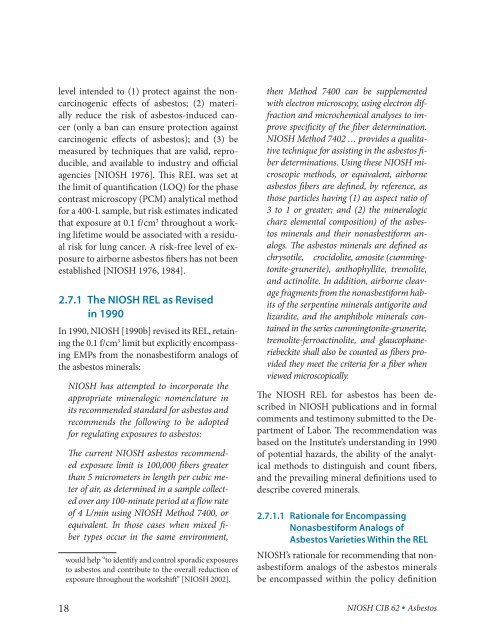Asbestos Fibers and Other Elongate Mineral Particles: State of the ...
Asbestos Fibers and Other Elongate Mineral Particles: State of the ...
Asbestos Fibers and Other Elongate Mineral Particles: State of the ...
- No tags were found...
You also want an ePaper? Increase the reach of your titles
YUMPU automatically turns print PDFs into web optimized ePapers that Google loves.
level intended to (1) protect against <strong>the</strong> noncarcinogenic<br />
effects <strong>of</strong> asbestos; (2) materially<br />
reduce <strong>the</strong> risk <strong>of</strong> asbestos-induced cancer<br />
(only a ban can ensure protection against<br />
carcinogenic effects <strong>of</strong> asbestos); <strong>and</strong> (3) be<br />
measured by techniques that are valid, reproducible,<br />
<strong>and</strong> available to industry <strong>and</strong> <strong>of</strong>ficial<br />
agencies [NIOSH 1976]. This REL was set at<br />
<strong>the</strong> limit <strong>of</strong> quantification (LOQ) for <strong>the</strong> phase<br />
contrast microscopy (PCM) analytical method<br />
for a 400-L sample, but risk estimates indicated<br />
that exposure at 0.1 f/cm 3 throughout a working<br />
lifetime would be associated with a residual<br />
risk for lung cancer. A risk-free level <strong>of</strong> exposure<br />
to airborne asbestos fibers has not been<br />
established [NIOSH 1976, 1984].<br />
2.7.1 The NIOSH REL as Revised<br />
in 1990<br />
In 1990, NIOSH [1990b] revised its REL, retaining<br />
<strong>the</strong> 0.1 f/cm 3 limit but explicitly encompassing<br />
EMPs from <strong>the</strong> nonasbestiform analogs <strong>of</strong><br />
<strong>the</strong> asbestos minerals:<br />
18<br />
NIOSH has attempted to incorporate <strong>the</strong><br />
appropriate mineralogic nomenclature in<br />
its recommended st<strong>and</strong>ard for asbestos <strong>and</strong><br />
recommends <strong>the</strong> following to be adopted<br />
for regulating exposures to asbestos:<br />
The current NIOSH asbestos recommended<br />
exposure limit is 100,000 fibers greater<br />
than 5 micrometers in length per cubic meter<br />
<strong>of</strong> air, as determined in a sample collected<br />
over any 100-minute period at a flow rate<br />
<strong>of</strong> 4 L/min using NIOSH Method 7400, or<br />
equivalent. In those cases when mixed fiber<br />
types occur in <strong>the</strong> same environment,<br />
would help “to identify <strong>and</strong> control sporadic exposures<br />
to asbestos <strong>and</strong> contribute to <strong>the</strong> overall reduction <strong>of</strong><br />
exposure throughout <strong>the</strong> workshift” [NIOSH 2002].<br />
<strong>the</strong>n Method 7400 can be supplemented<br />
with electron microscopy, using electron diffraction<br />
<strong>and</strong> microchemical analyses to improve<br />
specificity <strong>of</strong> <strong>the</strong> fiber determination.<br />
NIOSH Method 7402 … provides a qualitative<br />
technique for assisting in <strong>the</strong> asbestos fiber<br />
determinations. Using <strong>the</strong>se NIOSH microscopic<br />
methods, or equivalent, airborne<br />
asbestos fibers are defined, by reference, as<br />
those particles having (1) an aspect ratio <strong>of</strong><br />
3 to 1 or greater; <strong>and</strong> (2) <strong>the</strong> mineralogic<br />
charz elemental composition) <strong>of</strong> <strong>the</strong> asbestos<br />
minerals <strong>and</strong> <strong>the</strong>ir nonasbestiform analogs.<br />
The asbestos minerals are defined as<br />
chrysotile, crocidolite, amosite (cummingtonite-grunerite),<br />
antho phyllite, tremolite,<br />
<strong>and</strong> actinolite. In addition, airborne cleavage<br />
fragments from <strong>the</strong> nonasbestiform habits<br />
<strong>of</strong> <strong>the</strong> serpentine minerals antigorite <strong>and</strong><br />
lizardite, <strong>and</strong> <strong>the</strong> amphibole minerals contained<br />
in <strong>the</strong> series cumming tonite-gruner ite,<br />
tremolite-ferroactinolite, <strong>and</strong> glauco phanerie<br />
beck ite shall also be counted as fibers provided<br />
<strong>the</strong>y meet <strong>the</strong> criteria for a fiber when<br />
viewed microscopically.<br />
The NIOSH REL for asbestos has been described<br />
in NIOSH publications <strong>and</strong> in formal<br />
comments <strong>and</strong> testimony submitted to <strong>the</strong> Department<br />
<strong>of</strong> Labor. The recommendation was<br />
based on <strong>the</strong> Institute’s underst<strong>and</strong>ing in 1990<br />
<strong>of</strong> potential hazards, <strong>the</strong> ability <strong>of</strong> <strong>the</strong> analytical<br />
methods to distinguish <strong>and</strong> count fibers,<br />
<strong>and</strong> <strong>the</strong> prevailing mineral definitions used to<br />
describe covered minerals.<br />
2.7.1.1 Rationale for Encompassing<br />
Nonasbestiform Analogs <strong>of</strong><br />
<strong>Asbestos</strong> Varieties Within <strong>the</strong> REL<br />
NIOSH’s rationale for recommending that nonasbestiform<br />
analogs <strong>of</strong> <strong>the</strong> asbestos minerals<br />
be encompassed within <strong>the</strong> policy definition<br />
NIOSH CIB 62 • <strong>Asbestos</strong>

















